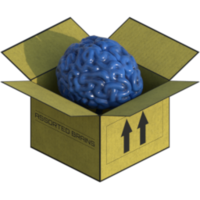|
Quaternion Questions
I''m new to quats but have spent most of today toying with other peoples code and mealting my brain on math sites.
I can seem to make much sence of what I''m reading. I''m currently using Nick Capen''s quat\matrix\vector code to learn from as it seems the cleanest I''ve found(at glvelocity.gamedev.net).
The way I have my system organised is each object has two quats, world and local. I think I understand how to set my Euler coordinates ~
Chris Brodie
I use Q''s to do movement, if you search for input and Magmai you should come across the code that i''ve posted.
Each object had a 3D Vector, which is the center of the object mesh, and a Q which is the orientation of the object.
To use a Q to rotate a moon around a planet, you''d have to make the center of the rotation, the center of the planet.
So you''d apply a translation so that the planets center is at 0,0,0. Then, you need the Q equivalent of a SLERP. Then apply the rotation to the moon. And translate the planet & moon back out to where it belongs. To apply the rotation, you need to convert the Q into a vector & an angle and call the appro. GL function.
A thing the Q''s are good for, is if you have two rotations you want to concatenate; you just multiple the Q representations. The resultant Q, when translated back into a vector & an angle, gives you the resultant rotatation.
So make an ''identity'' Q, and then create a rotation Q that represents the rotation you want. Set a w:rps (radians per second) that controls how fast the moon spins around the planet, and multiply by the elapsed time. Convert this angle into a Q (can pick any vector to rotation about... just changes which direction around the planet it goes...) and multiple the existing rotation Q by this new one. The result is the new rotation, hang onto it for next time.
Might need to worry about iteration error....
Magmai Kai Holmlor
- The disgruntled & disillusioned
Each object had a 3D Vector, which is the center of the object mesh, and a Q which is the orientation of the object.
To use a Q to rotate a moon around a planet, you''d have to make the center of the rotation, the center of the planet.
So you''d apply a translation so that the planets center is at 0,0,0. Then, you need the Q equivalent of a SLERP. Then apply the rotation to the moon. And translate the planet & moon back out to where it belongs. To apply the rotation, you need to convert the Q into a vector & an angle and call the appro. GL function.
A thing the Q''s are good for, is if you have two rotations you want to concatenate; you just multiple the Q representations. The resultant Q, when translated back into a vector & an angle, gives you the resultant rotatation.
So make an ''identity'' Q, and then create a rotation Q that represents the rotation you want. Set a w:rps (radians per second) that controls how fast the moon spins around the planet, and multiply by the elapsed time. Convert this angle into a Q (can pick any vector to rotation about... just changes which direction around the planet it goes...) and multiple the existing rotation Q by this new one. The result is the new rotation, hang onto it for next time.
Might need to worry about iteration error....
Magmai Kai Holmlor
- The disgruntled & disillusioned
- The trade-off between price and quality does not exist in Japan. Rather, the idea that high quality brings on cost reduction is widely accepted.-- Tajima & Matsubara
This topic is closed to new replies.
Advertisement
Popular Topics
Advertisement
Recommended Tutorials
Advertisement





